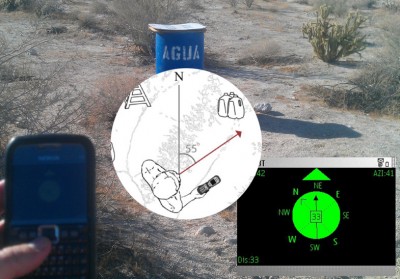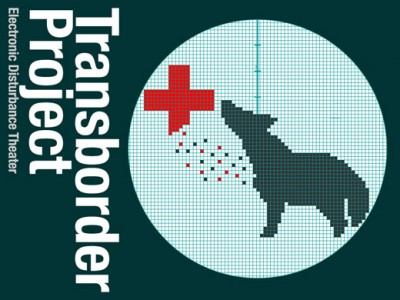In the 1990s, Electronic Disturbance Theater 1.0 was an autonomous group of artists creating online art projects that, among other things, produced responses from the Department of Defense to agents of the Mexican government. These entities, however, failed to establish any national or international investigations accusing EDT 1.0 of breaking computer laws, which might have halted our future gestures. In 2010––with Electronic Disturbance Theater 2.0––our stage was completely different. The Transborder Immigrant Tool (TBT) and our Electronic Civil Disobedience performances were now being developed and performed with the support of large institutions, notably the University of California and CALIT2 (a new-edge technology research center) at UC San Diego, where I have been running b.a.n.g. lab (bits.atoms.neurons.genes) since 2004. I received tenure in 2009 for this art-based research and for projects like TBT, which I developed in collaboration with artists and scholars Brett Stalbaum, micha cárdenas, Amy Sara Carroll, and Elle Mehrmand.
TBT began in 2007, under the shade of Tim Hawkinson’s giant “Bear” sculpture in front of CALIT2, where Brett and I were having coffee. We began with a basic question: what ubiquitous technology would allow us to create an inexpensive tool to support the locating of water caches left in the Southern California desert by NGOs? Our answer was that the under-20$ iMotorola phone series could work for emergency navigation purposes; this platform could be made reasonably useful in a better-than-nothing scenario. In 2008, we were joined by micha cárdenas and Elle Mehrmand, who were MFA students in the Visual Arts Department at the time, and also by experimental poet and scholar Amy Sara Carroll.

Electronic Disturbance Theater 1.0/2.0 has always been invested in the use of experimental poetry as part of our gestures––from the found poetry in 404 file not found, which was part of our ECD performances in the 1990s, to the 2000 border hack actions with the Zapatista Tribal Port Scan, in which we scanned and uploaded Zapatista poems that we had written onto U.S. Border Patrol servers. As we started to develop the TBT project, it became important once again to have poetry as a core component of the gesture. In 2008, Amy Sara Carroll––my partner, who is also a researcher focusing on Mexican/U.S. border art––thought that if TBT were to become a geo-poetic-system (GPS), this could expand the frame of both experimental poetry and artivism. By establishing a geo-aesthetic sensibility, we could work with and around the notion of GPS (Global Positioning System), as well as any laws that the U.S. might attempt to use in order to halt the gesture. It was no longer a question of the application of a preexisting technology, but rather of a gesture that dis-located the urbanism of locative media. began working with us on the project, establishing two geo-poetic tracks: one conceptual––based on current poetic practicesnd the other an echo of desert survival manuals performed in multiple languages.
The latter speaks, of course, to the multiple borders that crisscross the planet as well as the multiple languages that cross the Mexico/U.S. border via immigrants. Here is Amy speaking about TBT:
My collaboration with Electronic Disturbance Theatre (EDT) on the Transborder Immigrant Tool…[is] imagined as a global project under development, my own involvement in that ongoing process is linked to the question of what constitutes sustenance in the quotidian of the conceptual, on the varied musical scales of the micro and macro. For often—and rightly enough—conversations about crossing the Mexico-U.S. border refer to disorientation, sun exposure, lack of water. The Transborder Immigrant Tool attempts to address those vicissitudes, but also to remember that the aesthetic—freighted with the unbearable weight of ‘love’—too, sustains. A poetic gesture from its inception, the Transborder Immigrant Tool functions, via the aspirations of such a dislocative medium, as dislocative media, seeking to realize the possibilities of G.P.S. as both a ‘global positioning system’ and, what, in another context, Laura Borràs Castanyer and Juan B. Gutiérrez have termed, a ‘global poetic system.’ The Transborder Immigrant Tool includes poems for psychic consultation, spoken words of encouragement and welcome, which I am writing and co-designing in the mindset of Audre Lorde’s pronouncement that “poetry is not a luxury[.]” [This] speaks to the Transborder Immigrant Tool’s overarching commitment to global citizenship. For the excerpt, itself infused with the ‘transversal logic’ of the poetic, acts as one of the Transborder Immigrant Tool’s internal compasses, clarifying the ways and means by which I and my collaborators approach this project as ethically inflected, as transcending the local of (bi)national politics, of borders and their policing.
TBT––and all of the artists working on it––came under investigation on January 11th, 2010, by UCSD. I then came under investigation for the Virtual Sit-In performance against the UC Office of the President (UCOP) on March 4th.The Sit-In had protested rising student fees in the UC system and the dismantling of educational support for K–12 across California. This was followed by an investigation by the FBI Office of Cybercrimes. The FBI sought to frame the performance as a federal violation––a cybercrime––based on UCOP’s statement that they had lost $5600 as a result of the disturbance. It is important to note that in order for something to be considered a cybercrime, the loss incurred must be over $5000. the actions taking place on the streets of California, the various occupations and protests across the UC campuses by students and faculty, and these online actions, created a heightened atmosphere in which the UCOP could not fail to notice––and attempt to minimize––the Virtual Sit-In’s impact.
There were three investigations in total. They all sought to find a way to stop the development of the TBT and to take away my tenure for doing the very work I had been both hired to do and tenured for. The irony was lost on no one, not even the FBI. In the end, all three investigations were dropped. UCSD could not find any evidence of a misuse of university funding for the TBT project (three Republican Congressmen had called for the investigations on these grounds). During these investigations, UCSD also analyzed the TBT project and our intellectual efforts based on some unknown financial model. The final outcome of this yearlong accounting investigation was:
Project Assessed to be an Appropriate Use of Fund on July 21st, 2010:
Based on our review procedures, we concluded that neither University funds nor effort were used inappropriately during the development of the TBT or the Project.
— San Diego: Audit & Management Advisory Services 0910 University of California. Subject: Use of Resources Investigation. Transborder Immigrant Tool AMAS Audit Project 2010-75 (July 21, 2010)
The strange part of this investigation was that UCSD never informed any member of EDT 2.0/b.a.n.g. lab about the investigation once it was over, nor were we told of its outcome. It was only a month later––and by accident––that I discovered this information. Subsequently, I requested the materials from the Audit & Management Advisory Services group. They claimed they had forgotten to send them.

I did have to agree, however, not to do another Virtual Sit-In performance against the UCOP for 4 years. As a side note, the day I signed this agreement, a number of supporters across the nation did another Virtual Sit-In against UCOP. UCSD dropped its actions to take away my tenure, choosing instead to commend me for my research. One strange aspect of the agreement that they wanted me to sign––without allowing me or my legal team time to look it over––was that it included clauses stating that I would never speak or write about what had happened, that I would never create any other artwork that might disturb anyone, and of course, that I would refrain from all future artivist performances. These elements were ultimately removed from the final agreement I signed with UCSD. How could we continue to do our research if I did?
TBT was also targeted by the right-wing media, specifically Fox News, which caused an influx of extremely violent emails directed at the members of EDT 2.0/b.a.n.g. lab. We could always tell when a story about TBT had appeared on Fox News because of the number of emails that immediately flooded our inboxes. Because of the aggressive harassment that we were now receiving, we had to meet with the Department of Justice several times in order to alert––and ask for protection from––those who had previously been investigating us.
Here is one email that we received:
Author : Leonard (IP: 173.128.108.219 , 173-128-108-219.pools.spcsdns.net)
E-mail : yourworstnightmare444@yahoo.com
URL :
Whois : https://ws.arin.net/cgi-bin/whois.pl?queryinput=173.128.108.219 Comment: Hopefully, you traitors will be shot in the back of your heads when you least expect it.
Isn’t it great that you’re relying upon the tax money of Americans to destroy America. Nearly all illegals from Mexico and Central America are NOT Spanish Europeans, but indigenous morons who never invented the wheel.
FUCK YOU!
Another strange and highly critical response to TBT came from Glenn Beck, who on both his website and his old Fox News show insisted that TBT’s poetry would “dissolve” the nation! This is, indeed, the power of poetry, which is often disregarded by supporters of the project. This is the power of poetry and the aesthetic more broadly. TBT also received extremely supportive responses from Water Station Inc. and Border Angels––both NGOs that have been working for more than a decade leaving water caches along the Anza-Borrego area of Southern California. EDT 2.0./b.a.n.g. lab was very lucky to be able to work with them, for without them, we could not have created the locative wave points that TBT uses to navigate its users toward the water caches. Another very important site of dissemination for TBT has been the curators, critics, scholars, and artists/artivists who have chosen both to speak out about the project and to exhibit it.
In 2011, we were finally ready to complete the project by distributing TBT in Mexico. By this time however, the Narcos were in control of the informal economies of border crossing. This made the project too dangerous for migrants to use, since the Narcos kill people for just about anything that might alert U.S. border agents that a crossing is happening. Even though TBT had only limited emergency cellphone capabilities, the risk that someone might get killed because they had a TBT phone on them was too much for us. We felt that we could not distribute the phones under such conditions. But while TBT did not achieve its imagined goal, the gesture created a series of calls and responses resonating on a global scale, which may yet bloom in the desert of the real.
P.S.: The TBT’s code is available on-line to download at walkingtools.net, sans water cache locations, for any individual or community to use for their own GPS investigations.
These responses ranged from government agents contacting EDT 1.0 while we were at the “Info Wars” new media art gathering at Ars Electronica in Linz, Austria, warning us not to carry out one of our gestures ––the “SWARM” gesture –– because they knew where our families were; to the Department of Defense launching the first known “information war weapon” on our server (Thing.net) in New York City; to the FBI accusing us of cyberterrorism when we shut down the World Economic Forum in New York City right after 9/11; to the NSA inviting us to come meet and do a performance for them in 1999.
